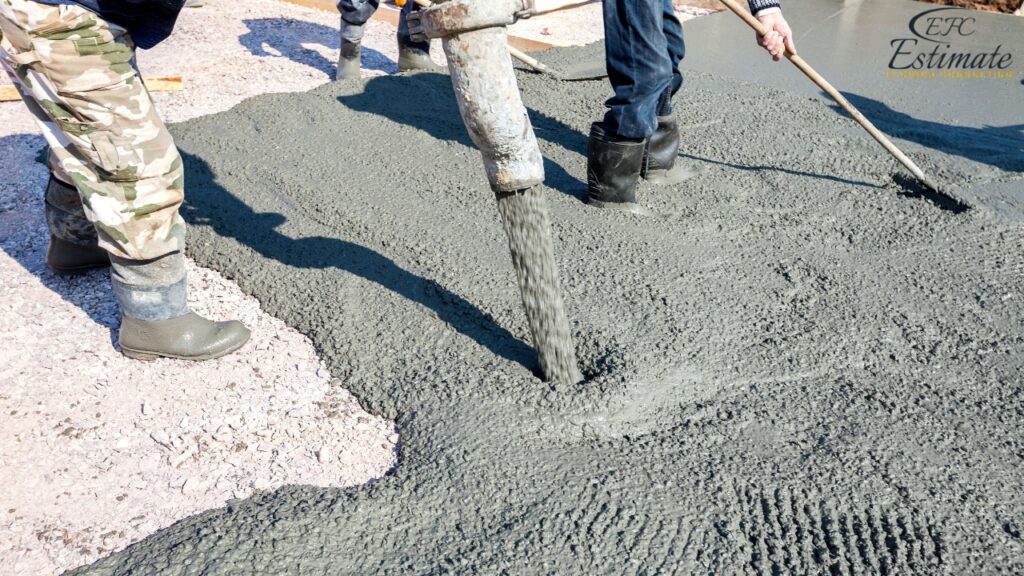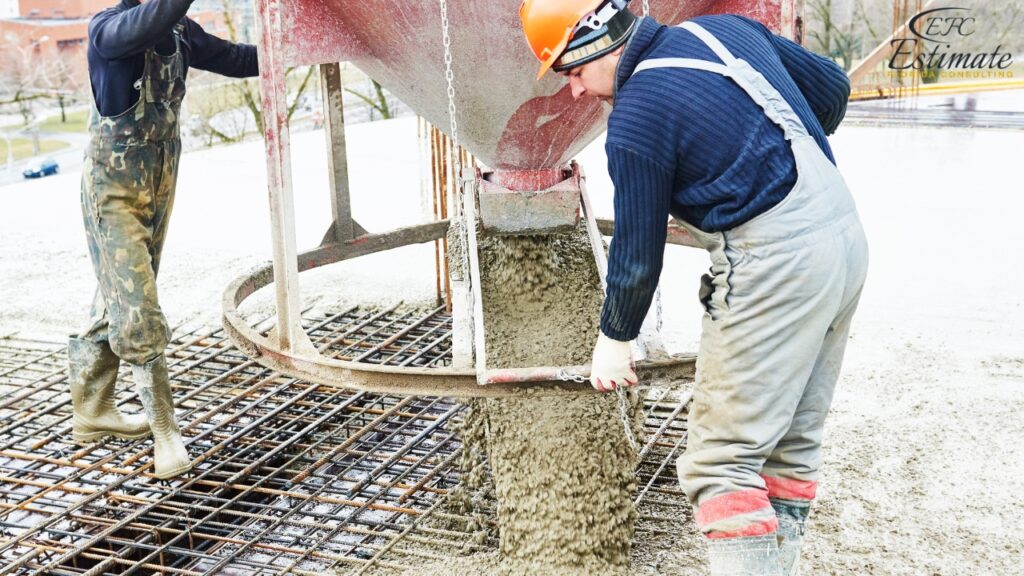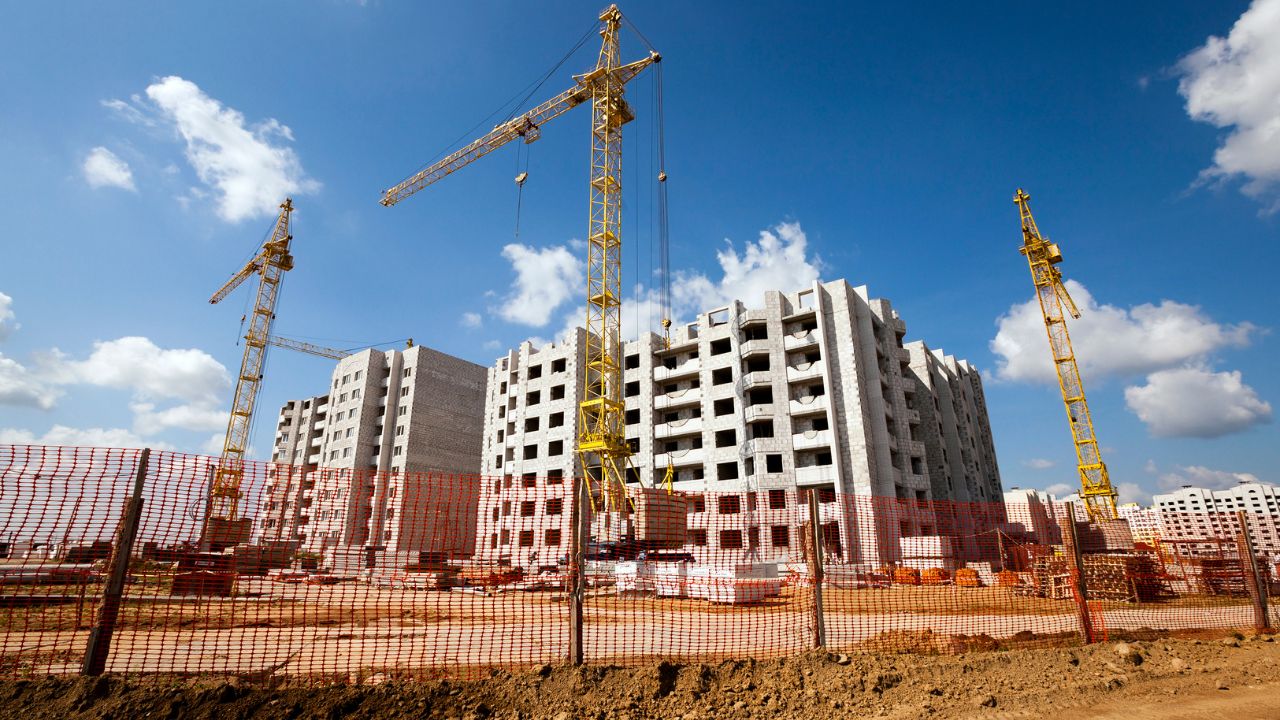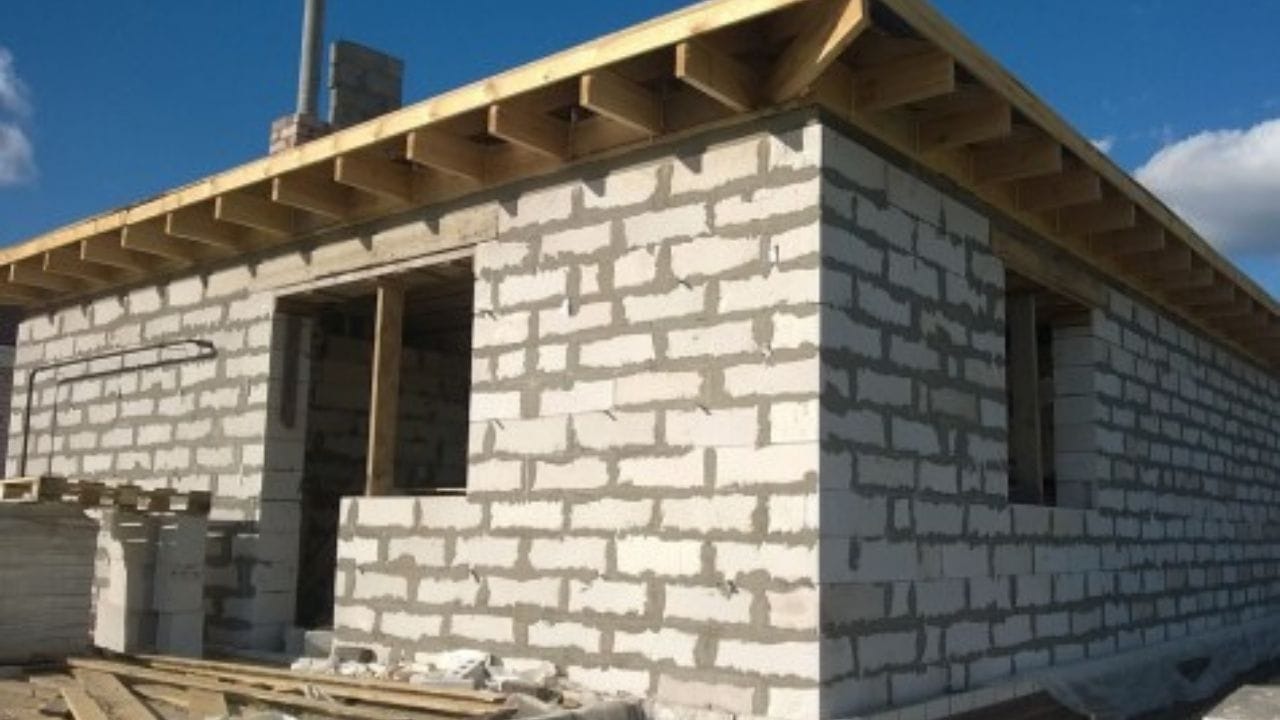Multi-Family Building Concrete Takeoff Service
Estimate Florida Consulting offers specialized Concrete Takeoff Services for multi-family building projects, both commercial and residential. Our expert team provides precise budgeting and estimates, ensuring accuracy and efficiency in material quantities and labor costs. Utilizing advanced technology and industry best practices, we assess every aspect of the concrete requirements, from foundation work to structural elements. Our detailed takeoff services streamline the planning process, minimize risks, and optimize resource allocation. Whether it’s a new construction project or a renovation, our comprehensive approach ensures that your project stays on budget and schedule.

Concrete Cost Per Square Foot for Multi-Family Construction
Constructing a multi-family building entails various costs, with concrete being a significant expense. On average, concrete costs between $121 to $182 per cubic yard, excluding labor. Additionally, installation expenses range from $8.80 to $19.80 per square foot for pouring and setting. These costs can vary due to factors like material availability, labor rates, and project complexity. Despite the financial commitment, prioritizing quality concrete is vital for durable and structurally sound construction. Effective budgeting and planning are essential to optimize resource utilization and uphold project quality and integrity.
Concrete Cost Estimator for Multi-Family Building Projects
The cost of concrete for Multi-Family construction can vary depending on the scale of the project. Larger projects tend to incur higher expenses. For instance, a full truckload of concrete, typically 8 to 10 cubic yards, averages between $1,127 and $1,535. Smaller projects, requiring less concrete, range from $165 to $225 per cubic yard. These figures include an additional short load fee of around $44 per cubic yard for orders below a full truckload.
It’s important to note that the short load fee is an extra charge imposed for orders that do not meet the full truckload requirement. While this fee can vary among suppliers, it typically averages around $44 per cubic yard. Below is a breakdown of the typical cost range for various concrete quantities, considering the inclusion of the short load fee for orders under 10 cubic yards.
Cubic Yards of Concrete | Price Range (Concrete + Short Load Fee) |
1 | $165 – $225 |
2 | $330 – $451 |
3 | $495 – $676 |
4 | $660 – $902 |
5 | $825 – $1,128 |
6 | $990 – $1,353 |
7 | $1,155 – $1,578 |
8 | $1,320 – $1,804 |
9 | $1,485 – $2,029 |
10 | $1,221 – $1,815 |
15 | $1,815 – $2,722 |
20 | $2,420 – $3,630 |
25 | $3,025 – $4,538 |
30 | $3,630 – $5,445 |
Factors Influencing Multi-Family Construction Costs
As you embark on the journey of constructing a Multi-Family building, understanding the factors impacting costs is crucial. You might be pondering over the expenses involved, which typically range from $104 to $154 per cubic yard of concrete. However, pinpointing the exact figure within this spectrum can be somewhat challenging. Various factors come into play, such as the distance from the concrete supplier and the necessity for weekend deliveries, which could add extra charges to your final bill.
- Type of Concrete: The strength of the concrete directly correlates with the expenses incurred.

- Delivery Distance: The farther your Multi-Family site is from the concrete supplier, the higher the transportation costs.
- Delivery Schedule: Weekend deliveries may attract additional fees, affecting the overall expenditure.
- Pre-Mixed Concrete Bags: While pre-mixed concrete bags offer convenience, they may not always be the most cost-effective option compared to bulk purchases.
Type of concrete
The cost of concrete varies depending on its type, primarily determined by its strength, often quantified in PSI (pounds per square inch). A higher PSI rating signifies stronger and pricier concrete per cubic yard.
For critical applications such as Multi-Family driveways or foundations demanding exceptional durability and load-bearing capabilities, opting for a high PSI concrete mix is recommended.
Conversely, for Multi-Family projects like patios and walkways, where heavy load support isn’t necessary, a lower PSI concrete mix can suffice, often at a lower cost per cubic yard.
Concrete Installation Services
To ensure efficiency and cost-effectiveness, engaging a professional concrete installer is advisable for your concrete pouring requirements. The expenses you anticipate will fluctuate based on the particular project you’re undertaking. Here’s a breakdown of common concrete installations along with their average costs:
Type of Installation | Installation Price Range per Square Foot (excluding concrete cost) |
Basic Concrete Slab | $4.87 – $8.50 |
Concrete Patio | $10.22 – $11.04 |
Reinforced Concrete | $4.84 – $17.60 |
Concrete Foundation | $4.95 – $16.50 |
Concrete Driveway | $6.60 – $15.40 |
Stamped Concrete | $9.90 – $17.88 |
How much does a cubic yard of concrete cover?
The thickness of a concrete slab is pivotal in determining the coverage area for a cubic yard of poured concrete. This requirement is influenced by the anticipated weight the slab will support.
Below is a table showcasing the coverage area, measured in square feet, for one cubic yard of concrete at different thicknesses.
Slab Thickness | Area Covered by One Cubic Yard of Concrete |
4 inches | 81 square feet |
5 inches | 65 square feet |
6 inches | 54 square feet |
7 inches | 46 square feet |
8 inches | 41 square feet |
10 inches | 32 square feet |
12 inches | 27 square feet |
Download Template For Concrete Project Breakdown
- Materials list updated to the zip code
- Fast delivery
- Data base of general contractors and sub-contractors
- Local estimators

Concrete Delivery Options for Multi-Family Construction
Ready Mix Truck
Utilizing a ready mix truck involves the delivery company pre-mixing the concrete off-site and transporting it to your Multi-Family property. This method is optimal for large-scale projects such as Multi-Family foundations, ensuring consistent quality and ample quantities. However, for smaller Multi-Family projects, there may be some excess concrete, leading to potential waste. The delivery fee, typically encompassing transportation costs, averages around $22 per cubic yard. It’s important to note that this cost is already integrated into the total per-cubic-yard prices mentioned earlier.
Volumetric Truck
A volumetric concrete truck mixes concrete on-site, offering benefits such as minimized waste and enhanced flexibility. Since the concrete is blended as required, there’s reduced risk of overestimating the necessary amount, potentially saving on material expenses. Moreover, for Multi-Family projects encompassing various concrete needs simultaneously, a volumetric truck permits on-site mixing of different concrete types. For example, starting with a standard mix for Multi-Family walkways and transitioning to a higher-PSI mix for Multi-Family driveways or foundations is feasible. However, this method tends to incur a slightly higher cost, averaging around $27.50 per cubic yard for delivery due to the additional work associated with on-site mixing.
Tow-Behind Concrete Mixer
Tow-behind concrete mixers, smaller and more portable than full-sized trucks, are suitable for minor Multi-Family projects like repairing sections of walkways or sidewalks. Typically mounted on a trailer, they are towed to the Multi-Family site by a professional. While convenient for small-scale Multi-Family jobs, they may not be economically viable for larger projects due to their limited capacity. Delivery charges for this method range from $11 to $16.50 per cubic yard, contingent upon factors such as distance and site accessibility.

Concrete Bag Coverage for 1 Cubic Yard in Multi-Family Construction
Opting for pre-mixed bags might seem convenient; however, a substantial quantity is typically required to match the volume of one cubic yard of concrete. These bags, usually ranging from 40 to 80 pounds, generally yield less than one cubic foot of concrete each.
For a precise calculation of the necessary number of bags and an estimation of associated costs, contemplate purchasing in bulk from a concrete company. Bulk acquisitions frequently lead to reduced overall project expenses compared to purchasing individual bags.
Bag Size | Total Cubic Feet (on average) |
40 lbs | 0.3 cubic feet |
60 lbs | 0.45 cubic feet |
80 lbs | 0.6 cubic feet |
DIY vs. Professional Installation
DIY concrete installation can be feasible with thorough planning and preparation. However, it’s essential to acknowledge the significant time and labor involved. Allocate at least a week for the entire process, including form preparation, concrete pouring, and curing. While the installation itself may seem straightforward, various factors and steps can complicate the process, potentially making it more challenging than anticipated.
Key considerations include obtaining necessary permits, properly leveling and grading the sub-surface, ensuring adequate staking and bracing of the frame, and executing proper finishing techniques post-pouring. Researching finishing methods is crucial to avoid applying finishes too early or too late in the curing process. Additionally, it’s crucial to take appropriate safety precautions when working with wet concrete to prevent chemical burns.
Although DIY installation typically incurs lower costs than hiring professionals, the time and effort required may not justify the savings, especially for complex or large projects. Before committing to a DIY approach, it’s advisable to consult with a professional contractor to obtain a project estimate. Comparing this estimate with your DIY budget will help you make an informed decision regarding the most suitable approach for your project.
Get 5 New Leads Next 7Days With Our System
- Multi-Family Building
- Hotel Building
- Hospital Building
- Warehouse Building
- High-Rise Building
- Shopping Complex
Conclusion
Estimate Florida Consulting provides specialized Concrete Takeoff Services tailored for Multi-Family buildings, ensuring precise estimation and budgeting. Recognizing the significant expense of concrete in Multi-Family construction, we emphasize effective budgeting and planning to optimize resources. Factors such as concrete type, delivery options, and installation services impact project costs, necessitating careful consideration. While DIY installation may seem cost-effective, it requires extensive time and effort, with potential complexities. Engaging professional concrete installers ensures efficiency and quality, particularly for complex projects. Our commitment lies in providing detailed and reliable estimates to keep Multi-Family construction projects on schedule and within budget. With our expertise, clients can confidently navigate the intricacies of concrete procurement and installation, achieving successful outcomes for their projects.
FAQs
Calculating concrete takeoff involves several steps to determine the quantity of concrete needed for a construction project accurately. Here’s a comprehensive guide:
- Gather Project Details: Collect all relevant information about the project, including architectural drawings, structural plans, and specifications.
- Identify Concrete Elements: Review the plans to identify all concrete elements, such as slabs, footings, columns, walls, and beams.
- Measure Dimensions: Measure the dimensions of each concrete element using the architectural drawings. Record the length, width, and thickness or depth of each component.
- Calculate Volume: Calculate the volume of each concrete element by multiplying its length, width, and thickness (or depth). For irregular shapes, use appropriate formulas to calculate volume.
- Consider Waste and Overages: Factor in waste and overages typically ranging from 5% to 10% to account for spillage, uneven surfaces, and unforeseen circumstances.
- Convert Volume to Cubic Yards: Convert the calculated volume from cubic feet to cubic yards, as concrete is typically sold and priced by the cubic yard. Divide the volume by 27 (since 1 cubic yard equals 27 cubic feet).
- Summarize Quantities: Total the cubic yardage for all concrete elements to get the overall concrete takeoff quantity for the project.
- Review and Verify: Double-check all measurements and calculations to ensure accuracy. Compare the calculated quantities with project requirements and specifications.
- Adjust for Special Considerations: Consider any special requirements or considerations for the project, such as reinforcement, formwork, or specific concrete mixes, and adjust the quantities accordingly.
- Documentation: Document the concrete takeoff calculations and provide detailed reports or estimates as needed for project planning, budgeting, and procurement.
Takeoffs are crucial for accurate project estimation, budgeting, and procurement. They provide detailed lists of materials and quantities, allowing construction professionals to assess costs, create bids, and plan project timelines effectively. Takeoffs are typically performed by estimators or quantity surveyors who meticulously review construction drawings and specifications to determine the exact amounts of materials needed to complete the project as per the design intent.
Concrete takeoff is the process of determining the precise quantity of concrete required for a construction project. It involves analyzing architectural and engineering drawings to identify concrete elements such as slabs, footings, walls, and columns. By measuring dimensions and calculating volumes, estimators ascertain the exact amount of concrete needed. This information is crucial for accurate project estimation, budgeting, and procurement, ensuring that the right amount of concrete is delivered and utilized efficiently during construction.
Calculating concrete removal involves several steps to determine the quantity of concrete to be removed and disposed of from a construction site. Here’s a straightforward approach:
- Measure Dimensions: Measure the length, width, and thickness of the concrete structure slated for removal. If the concrete is irregularly shaped, break it down into geometric shapes for easier measurement.
- Calculate Volume: Multiply the length, width, and thickness to determine the volume of the concrete structure. For irregular shapes, use appropriate formulas for volume calculation.
- Convert Volume to Cubic Yards: Convert the volume from cubic feet to cubic yards since disposal services often charge by the cubic yard. Divide the volume by 27 (since 1 cubic yard equals 27 cubic feet).
- Consider Waste: Account for potential waste and inefficiencies during removal, typically ranging from 5% to 10% of the calculated volume.
- Summarize Quantities: Total the cubic yardage of all concrete structures slated for removal to obtain the overall quantity of concrete to be disposed of.
- Plan for Disposal: Determine the method of disposal, whether it’s through a waste management company, recycling facility, or other means. Consider associated costs and environmental regulations.
- Review and Verify: Double-check measurements and calculations for accuracy to ensure the removal process is adequately planned and budgeted.
To calculate the amount of concrete needed for a 1500 square feet area, you first need to determine the thickness of the concrete slab. Once you have the thickness, you can calculate the volume of concrete required.
For example, if you want to pour a concrete slab that is 4 inches thick:
- Convert the thickness from inches to feet (since there are 12 inches in a foot): 4 inches ÷ 12 = 0.333 feet.
- Multiply the area (in square feet) by the thickness (in feet) to get the volume (in cubic feet) of concrete needed: 1500 sq ft × 0.333 ft = 499.5 cubic feet.
- Convert the volume from cubic feet to cubic yards (since concrete is typically sold by the cubic yard, where 1 cubic yard equals 27 cubic feet): 499.5 cu ft ÷ 27 = approximately 18.5 cubic yards.
So, for a 1500 square feet area with a concrete thickness of 4 inches, you would need approximately 18.5 cubic yards of concrete. Keep in mind that this calculation is an estimate, and it’s always a good idea to add a little extra to account for waste or unexpected variations. Additionally, concrete suppliers often have minimum order requirements, so you may need to adjust the quantity accordingly.
Google Reviews



Process To Get Concrete Cost Estimate Report
Here I am going to share some steps to get concrete cost estimate report.
-
You need to send your plan to us.
You can send us your plan on info@estimatorflorida.com
-
You receive a quote for your project.
Before starting your project, we send you a quote for your service. That quote will have detailed information about your project. Here you will get information about the size, difficulty, complexity and bid date when determining pricing.
-
Get Estimate Report
Our team will takeoff and estimate your project. When we deliver you’ll receive a PDF and an Excel file of your estimate. We can also offer construction lead generation services for the jobs you’d like to pursue further.
Reach Out To Us
Places to visit if you new in Florida
Located in Orlando, this iconic destination is a dream come true for families and Disney enthusiasts alike. With four theme parks, two water parks, and countless entertainment options, it’s no wonder that Walt Disney World is one of the most visited vacation resorts in the world.
Famous for its glamorous beaches, vibrant nightlife, and Art Deco architecture, Miami Beach is a playground for sun-seekers and party-goers. South Beach, in particular, attracts visitors with its lively atmosphere and pristine sands.
Another gem in Orlando, Universal Orlando Resort offers thrilling rides, immersive attractions, and the magic of beloved movies and TV shows. From The Wizarding World of Harry Potter to adrenaline-pumping roller coasters, there’s something for everyone here.
This unique ecosystem is a UNESCO World Heritage Site and a haven for nature lovers. Visitors can explore the vast wetlands on airboat tours, spot alligators and diverse bird species, and learn about the importance of preserving this delicate environment.





